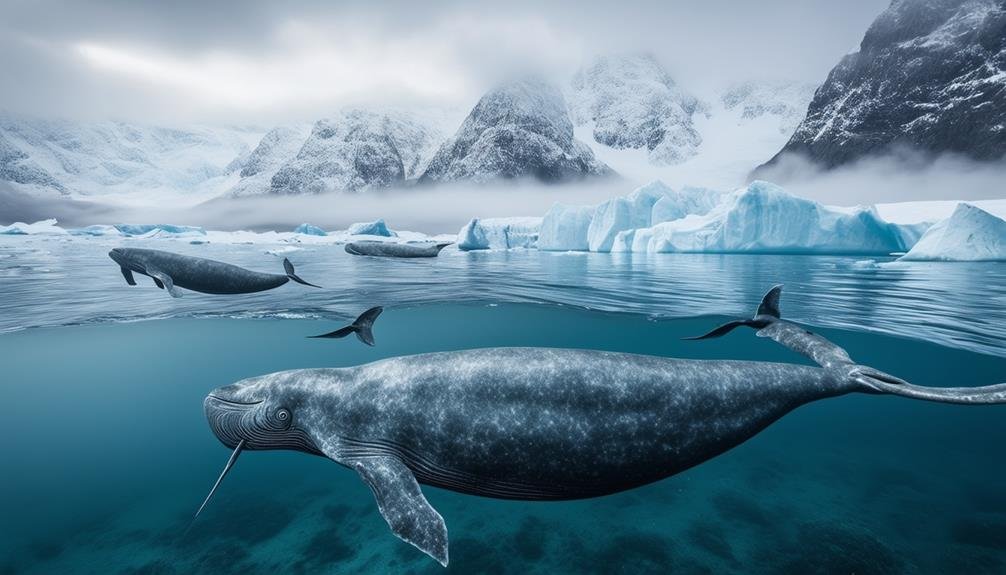To spot narwhals in the wild, focus on their spring migration, summer feeding grounds, and autumn journeys. During May and June, narwhals gather around Baffin and Bylot Islands, utilizing the ice floe edges. In summer, they migrate to shallow waters of Admiralty and Prince Regent Inlets for feeding. Finally, autumn sees narwhals setting out on extensive migrations through Lancaster Sound, traveling up to 3,000 kilometers as they prepare for winter months beneath the ice. Observing these 'unicorns of the sea' during these key times offers the best chances of witnessing their extraordinary behavior and natural habitat. Discover more insights by continuing ahead.
Main Points
- Spring (May – June): Narwhals can be observed at the floe edge around Baffin Island and Bylot Island.
- Lancaster Sound in Spring: Provides a prime vantage point for witnessing narwhals during their spring migration.
- Summer (July – August): Narwhals migrate to Admiralty Inlet and Prince Regent Inlet, feeding in shallow waters.
- Autumn (September – October): Narwhals travel through Lancaster Sound during their extensive autumn migration.
- Winter (November – May): Narwhals can be seen roaming between western Greenland and Canada under sea ice cover.
Spring Migration
During the spring journey, narwhals can be observed at the floe edge in May and June as they navigate the melting Arctic ice. This period marks a prime opportunity to witness these elusive animals around Baffin Island and Bylot Island. The narwhal, often referred to as the 'unicorn of the sea,' uses its distinctive tusk, which serves a sensory function, to aid in locating openings in the ice. This sensory capability is pivotal as the ice melts, guiding the narwhals through the challenging Arctic waters.
Lancaster Sound, a key area in the Arctic Kingdom, provides an ideal vantage point for observing narwhals during their spring journey. The floe edge, where solid ice meets open water, becomes a hub of activity as narwhal pods linger and explore cracks in the ice. These areas are essential for the narwhals as they progress closer to coastlines.
The Arctic waters around Baffin Island and Lancaster Sound are particularly favorable for spotting narwhals due to the dynamic ice conditions and the presence of these sensory-driven marine mammals. This time of year offers a rare glimpse into the narwhals' intricate migratory patterns and behaviors in their natural habitat.
Summer Feeding Grounds
In the summer months, narwhals migrate to regions such as Admiralty Inlet and Prince Regent Inlet, where they primarily feed on Arctic cod, Greenland halibut, and polar char. These areas serve as crucial summer feeding grounds where narwhals return to shallow waters, diving to depths between 30 and 300 meters to hunt for their preferred prey. However, spotting these elusive creatures can be challenging due to their unpredictable dispersal across various feeding areas.
Key imagery to bear in mind when visualizing summer feeding grounds:
- Glistening shallow waters: These regions provide a picturesque backdrop as narwhals dive gracefully in pursuit of Arctic cod.
- Varied marine life: The presence of Greenland halibut and polar char highlights the rich biodiversity that sustains narwhals during the summer.
- Remote arctic landscapes: The isolated and pristine environments of Admiralty Inlet and Prince Regent Inlet add to the experience of observing narwhals in their natural habitat.
Narwhal sightings in the summer depend heavily on the availability of food sources and environmental factors influencing their movements. While their feeding grounds can make sightings less predictable, the opportunity to witness narwhals in action offers a unique and enriching experience for wildlife enthusiasts.
Autumn/Winter Migration

As autumn sets in, narwhals begin their extensive journey through Lancaster Sound, covering an impressive distance and adapting to rapidly changing environmental conditions. This autumn voyage sees these remarkable cetaceans travel approximately 3,000 kilometers each year, maneuvering from their summer feeding grounds to their winter habitats. The journey through Lancaster Sound is pivotal as narwhals shift from the relatively ice-free summer months to the challenging conditions of winter.
As winter approaches, narwhals spend up to seven months under almost complete sea ice cover, primarily roaming between western Greenland and Canada. The winter travel routes are vital for their survival, allowing narwhals to access breathing holes and find sustenance beneath the ice. However, climate shifts can greatly impact the timing and pathways of their journey, introducing new challenges for these creatures.
The autumn voyage is an essential and fascinating aspect of the narwhal's yearly life cycle, highlighting their remarkable adaptability and resilience. Understanding these travel patterns is necessary for conservation efforts, particularly as climate shifts continue to alter the Arctic environment. Observing narwhals during this period offers unique insights into their behavior and the broader ecological dynamics of the Arctic region.
Conclusion
Observing narwhals in their natural habitat can be best achieved during three distinct periods: the spring migration, when these marine mammals travel to their summer feeding grounds; the summer months, when they gather in large numbers to feed and socialize; and the autumn and winter migration, as they journey back to their wintering areas. Each period offers unique opportunities to witness these elusive creatures, contributing to a thorough understanding of their behavior and ecology.


